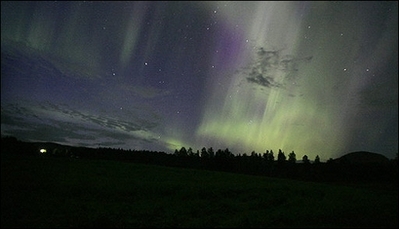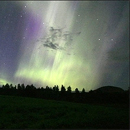Northern Lights flow on celestial magnetic ropes
AFP
December 10, 2007
NASA satellites have uncovered giant magnetic ropes linking the Earth's atmosphere to the Sun which channel solar energy to create spectacular Northern Lights shows, a study said Tuesday.
"The satellites have found evidence of magnetic ropes connecting Earth's upper atmosphere directly to the Sun," said David Sibeck, project scientist at NASA's Goddard Space Flight center.
"We believe that solar wind particles flow in along these ropes, providing energy for geomagnetic storms and auroras," he told the annual meeting of the American Geophysical Union.
The discovery was among a number of revelations by the US space agency's Time History of Events and Macroscale Interactions during Substorms mission (THEMIS) launched earlier this year.
A magnetic rope is a twisted bundle of magnetic fields much like a rope made of hemp, and although previous spacecraft have seen glimpses of them, none had been able to map their structure.
But the THEMIS's five identical micro-satellites could, Sibeck told the meeting in Sam Francisco.
"THEMIS encountered its first magnetic rope on May 20," he said. "It was very large, about as wide as Earth, and located approximately 40,000 miles (65,000 kilometers) above Earth's surface in a region called the magnetopause."
This is the region where solar wind hurtles into the Earth's magnetic fields, and magnetic ropes are formed and unfurled in just a few minutes allowing solar wind to be briefly conducted along them.
This enormous burst of energy helps explain the phenomenon of aurora borealis, also known as substorms, Sibeck said in a statement.
A substorm which erupted over Alaska and Canada on March 23 provided a stunning show of auroras for more than two hours.
They were photographed from below while satellites measured the particles and fields above, and showed a series of 10-minute outbursts.
The mission's principal investigator Vassilis Angelopoulos said the storm behaved very unexpectedly.
"The auroras surged westward twice as fast as anyone thought possible, crossing 15 degrees of longitude in less than one minute.
"The storm traversed an entire polar time zone, or 400 miles, in 60 seconds flat."
The total energy required for such a two-hour show was about five hundred thousand billion Joules, or the equivalent of a 5.5 magnitude earthquake, Angelopoulos said.
The THEMIS mission also witnessed small explosions on the outskirts of the Earth's magnetic field in an area known as the bow shock.
"The bow shock is like the bow wave in front of a boat," said Sibeck.
"It is where the solar wind first feels the effects of Earth's magnetic field. Sometimes a burst of electrical current within the solar wind will hit the bow shock and 'Bang!' we get an explosion."
THEMIS is a two-year mission being coordinated by the University of Berkeley in California, with several countries contributing to it.
Every four days the five THEMIS satellites line up along the Earth's magnetic field to follow disturbances in the magnetopause region. This allows the storms to be observed from five different angles simultaneously, helping scientists to learn about the origins of the storms and their evolutions.





 Share your thoughts in the Forum
Share your thoughts in the Forum
